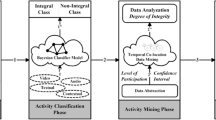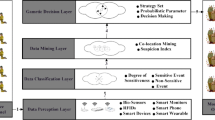Abstract
Innovations in the Internet of Things (IoT) technology have revolutionized several industrial domains for smart decision-modeling. The capacity to perceive data about ubiquitous instances has resulted in numerous innovations in sensitive sectors like national security, and police departments. In this paper, an extensive IoT-based framework is introduced for assessing the integrity of police personnel based on his/her performance. The work introduced in this research is centered around analyzing several activities of police personnel to assess his/her integral behavior. In particular, the Probabilistic Measure of Integrity (PMI) is formalized based on professional data analysis for classification based on Bayesian Model. Moreover, the 2-player game model has been presented to assess the performance of police personnel for efficient decision-making. For validation purposes, the presented framework is deployed over challenging datasets acquired from the online repository of UCI. Based on the comparative analysis with the state-of-the-art decision-making models, the presented approach has registered enhanced performance in terms of Temporal Delay, Classification, Prediction, Reliability, and Stability.










Similar content being viewed by others
References
Al-Garadi MA, Mohamed A, Al-Ali A, Du X, Ali I, Guizani M (2020) A survey of machine and deep learning methods for internet of things (iot) security. IEEE Commun Surv Tutor 22:1646–1685
Alsamhi SH, Ma O, Ansari MS, Gupta SK (2019) Collaboration of drone and internet of public safety things in smart cities: an overview of qos and network performance optimization. Drones 3(1):13
Bang J, Lee Y, Lee Y-T, Park W (2019) Ar/vr based smart policing for fast response to crimes in safe city. In: 2019 IEEE international symposium on mixed and augmented reality adjunct (ISMAR-Adjunct). IEEE, pp 470–475. https://doi.org/10.1109/ISMAR-Adjunct.2019.00126
Bhatia M (2020a) Fog computing-inspired smart home framework for predictive veterinary healthcare. Microprocess Microsyst 78:103227
Bhatia M (2020b) Iot-inspired framework for athlete performance assessment in smart sport industry. IEEE Internet Things J. https://doi.org/10.1109/JIOT.2020.3012440
Bhatia M, Sood SK (2016) Temporal informative analysis in smart-icu monitoring: M-healthcare perspective. J Med Syst 40(8):190
Bhatia M, Sood SK (2020) Quantum computing-inspired network optimization for iot applications. IEEE Internet Things J 7:5590–5598
Bhatia M, Sood SK, Kaur S (2020) Quantumized approach of load scheduling in fog computing environment for IoT applications. Computing 102:1097–1115. https://doi.org/10.1007/s00607-019-00786-5
Bromberg DE, Charbonneau É, Smith A (2020) Public support for facial recognition via police body-worn cameras: findings from a list experiment. Gov Inf Q 37(1):101415
Catlett C, Cesario E, Talia D, Vinci A (2019) Spatio-temporal crime predictions in smart cities: a data-driven approach and experiments. Pervasive Mob Comput 53:62–74
Dalwai T, James M, Webster W, Alshukaili AM, Soosaimanickam A (2019) An investigation of citizens e-participation within omans police department facebook page. International summit smart city. Springer, Berlin, pp 236–248
Davies A (2020) Iot, smart technologies, smart policing: the impact for rural communities. Smart village technology. Springer, Berlin, pp 25–37
de Macedo DDJ, de Araújo GM, Dutra ML, Dutra ST, Lezana ÁGR (2019) Toward an efficient healthcare cloudiot architecture by using a game theory approach. Concurr Eng 27(3):189–200
Gianini G, Fossi LG, Mio C, Caelen O, Brunie L, Damiani E (2020) Managing a pool of rules for credit card fraud detection by a game theory based approach. Future Gener Comput Sys 102:549–561
Iwendi C, Maddikunta PKR, Gadekallu TR, Lakshmanna K, Bashir AK, Piran MJ (2020) A metaheuristic optimization approach for energy efficiency in the IoT networks. Softw: Pract Exper. https://doi.org/10.1002/spe.2797
Kamruzzaman M (2020) E-crime management system for future smart city. Data processing techniques and applications for cyber-physical systems (DPTA 2019). Springer, Berlin, pp 261–271
Kaur N, Sood SK (2015) Cognitive decision making in smart industry. Comput Ind 74:151–161
Khan ND, Chrysostomou C, Nazir B (2020) Smart fir: securing e-fir data through blockchain within smart cities. In: 2020 IEEE 91st vehicular technology conference (VTC2020-Spring), pp 1–5
Mahmoudi R, Emrouznejad A, Khosroshahi H, Khashei M, Rajabi P (2019) Performance evaluation of thermal power plants considering Co2 emission: amultistage pca, clustering, game theory and data envelopment analysis. J Clean Prod 223:641–650
Nikkhah M, Ghasvareh M, Farzaneh Bahalgardi N (2019) Risk management in urban tunnels using methods of game theory and multi-criteria decision-making. J Min Environ 10(3):597–611
Sajjad M, Nasir M, Muhammad K, Khan S, Jan Z, Sangaiah AK, Elhoseny M, Baik SW (2020) Raspberry pi assisted face recognition framework for enhanced law-enforcement services in smart cities. Future Gener Comput Syst 108:995–1007
Sengupta J, Ruj S, Bit SD (2020) A comprehensive survey on attacks, security issues and blockchain solutions for iot and iiot. J Netw Comput Appl 149:102481
Shen HT, Liu L, Yang Y, Xu X, Huang Z, Shen F, Hong R (2020) Exploiting subspace relation in semantic labels for cross-modal hashing. IEEE Trans Knowl Data Eng. https://doi.org/10.1109/TKDE.2020.2970050
Solnon M, Arlot S, Bach F (2012) Multi-task regression using minimal penalties. J Mach Learn Res 13(1):2773–2812
Sun Y, Li J, Liu J, Sun B, Chow C (2014) An improvement of symbolic aggregate approximation distance measure for time series. Neurocomputing 138:189–198
Wang Y, Mori G (2009) Max-margin hidden conditional random fields for human action recognition. In: 2009 IEEE conference on computer vision and pattern recognition. IEEE, pp 872–879. https://doi.org/10.1109/CVPR.2009.5206709
Yamin MM, Shalaginov A, Katt B (2020) Smart policing for a smart world opportunities, challenges and way forward. Future of information and communication conference. Springer, Berlin, pp 532–549
Author information
Authors and Affiliations
Corresponding author
Additional information
Publisher's Note
Springer Nature remains neutral with regard to jurisdictional claims in published maps and institutional affiliations.
Rights and permissions
About this article
Cite this article
Ahanger, T.A., Bhatia, M. & Aldaej, A. Game theory-based performance assessment of police personnel. J Ambient Intell Human Comput 14, 511–526 (2023). https://doi.org/10.1007/s12652-021-03310-w
Received:
Accepted:
Published:
Issue Date:
DOI: https://doi.org/10.1007/s12652-021-03310-w




